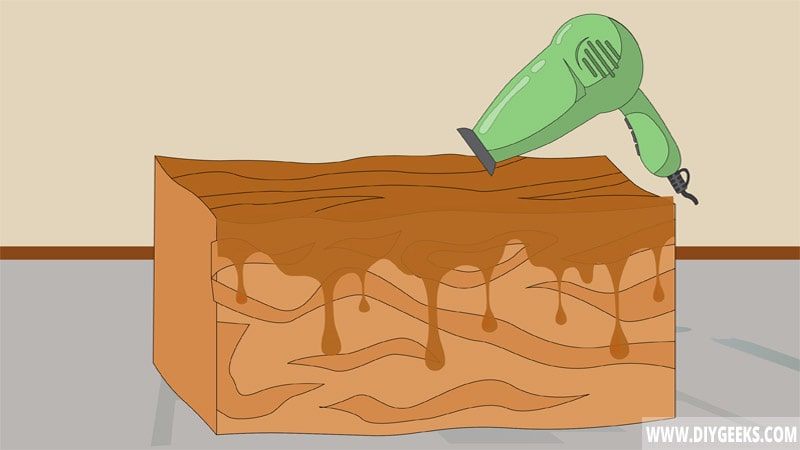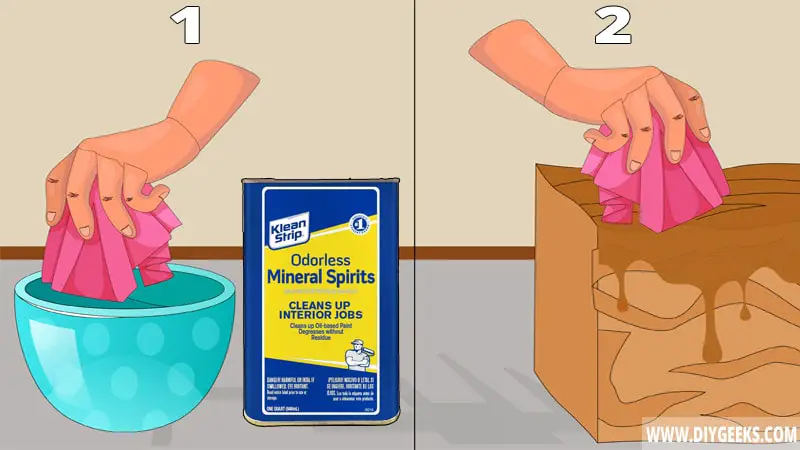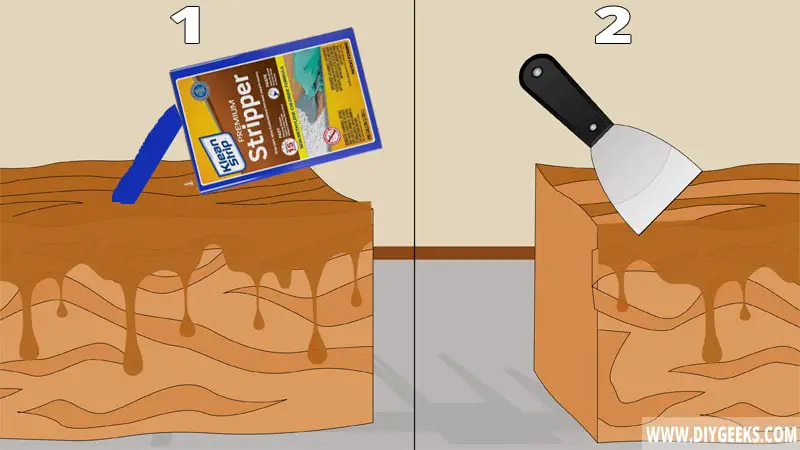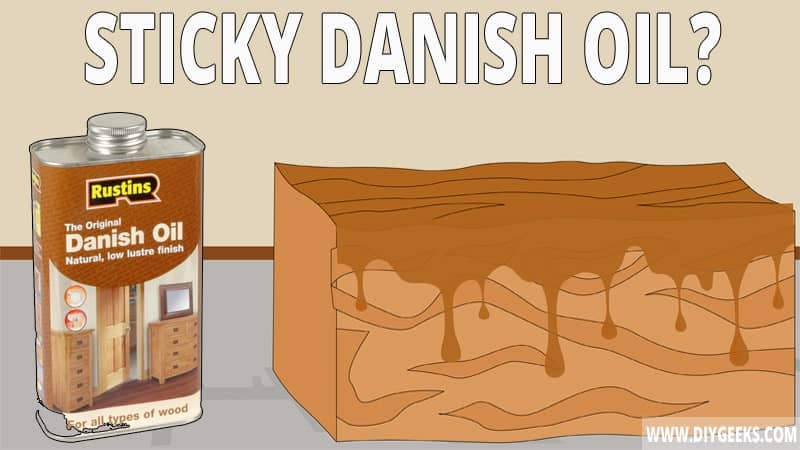A sticky Danish oil finish refers to a situation where the Danish oil remains wet or tacky for too long instead of drying to a hard or rigid finish.
The reasons Danish oil turns sticky include improper drying conditions, too many coats, or you re-coated too soon.
The fixes for sticky Danish oil include increasing the solvent evaporation rate, removing the excess, or using a paint-stripping solvent.
Why Does Danish Oil Turn Sticky?
Danish oil turns sticky for the following reasons.
- Improper Drying Conditions.
- Too Many Coats.
- You Re-coated Too Soon.
1. Improper Drying Conditions
Danish oil won’t dry properly and will remain wet or sticky longer if the drying conditions aren’t optimal. Low temperature and high humidity will increase the drying time as the solvent (oil) will take longer to evaporate from the coating.
For Danish oil to dry and not remain wet or sticky, the room temperature must be higher than 50°F (10°C) and the humidity levels lower than 50%.
2. Too Many Coats
If you apply too many Danish oil coats, the finish turns sticky or tacky as wood can’t absorb all of it. The Danish oil that wasn’t absorbed by the wood won’t dry and will remain wet over the top layer and prevent the absorbed coating from drying.
You must wipe the excess coating 30 minutes after applying it with a damp rag and allow the remaining to dry naturally.
If the wood surface is painted or sealed, the wood oil can’t penetrate it and will remain wet and tacky over the wood top layer. You must remove the paint or sealer before applying the wood oil.
3. You Recoated Too Soon
If you re-coat Danish oil too soon, the finish turns sticky or tacky as the existing coating is still wet and will prevent the new coating from drying.
Danish oil dries through evaporation — the solvent (oil) must evaporate and the coating must become hard (rigid) before you can re-coat it.
If you apply a new coating too soon, the existing coating solvent won’t evaporate and will prevent the new coating from adhering or drying, creating a tacky appearance.
Does Sticky Danish Oil Dry Eventually?
Sticky Danish oil does dry eventually if it’s caused by improper drying conditions, too many coats, or if you re-coated too soon.
In simple words, if the sticky Danish oil is caused because the solvent (oil) hasn’t evaporated yet, the finish will dry eventually after the solvent evaporates. Increase the heat around the coating to accelerate the evaporation rate and the coating will dry.
Sticky Danish oil doesn’t dry eventually if it’s caused by a wet surface, water leak, improper preparation, faulty surface, or if it’s been sticky for more than 48 hours. In this case, remove the Danish oil, fix the surface issues, and re-apply it.
How To Fix Sticky Danish Oil?
To fix sticky Danish Oil, do the following things.
- Increase the Solvent Evaporation Rate.
- Remove the Excess.
- Use a Paint-stripping Solvent.
1. Increase the Solvent Evaporation Rate.

Since Danish oil dries through evaporation, increase the solvent evaporation rate and the sticky finish will dry. The evaporation rate will increase if the coating is exposed to increased heat or if the humidity levels drop lower than 50%.
To increase the solvent evaporation rate, do the following things.
- Use a hair dryer at a medium temperature over the coating for 5 minutes only.
- Use a dehumidifier to decrease the humidity levels.
- Open all windows to improve the air circulation.
Don’t use the hair dryer for more than 5 minutes as it will cause the coating to dry too fast, which results in a weak or cracked finish.
2. Remove the Excess

If the Danish oil finish is sticky because you applied too many coats or re-coated too soon, wipe the excess with mineral spirits and allow the remaining to dry. Mineral spirits will dissolve the wood oil that hasn’t penetrated the wood surface.
The tools you need for this project are listed below.
- Mineral spirits
- Clean rags
- A clean bowl
- A plastic bag
To remove the excess Danish oil, do the following things.
- Damp a rag with mineral spirits.
- Use the dampened rag to wipe the sticky finish.
- Pour mineral spirits directly over the finish.
- Wait 30 minutes.
- Wipe the excess with a dry rag.
- Allow the remaining to dry.
3. Use a Paint-stripping Solvent

If the tacky finish is caused by a wet surface, water leak, or improper prep work, remove the finish, fix the issue, and re-apply it.
To remove Danish oil, use a paint-stripping solvent. The paint-stripping solvent will dissolve and remove multiple layers of wood oil. When this is done, inspect the surface to see what you did wrong, fix it, and re-apply the wood oil.
The tools you need for this project are listed below.
- Paint stripping solvent.
- A pair of gloves
- Sandpaper (80-220 grit)
- Mineral spirits
- Paint scraper
- A drop sheet
- A plastic bag
Here is a guide for this method:
- Clean the finish to remove dust or dirt.
- Prep the paint-stripping compound based on the manufacturer’s instructions.
- Apply a thick layer of paint-stripping compound over the surface.
- Wait 30 minutes.
- Use a paint scraper to remove the paint-stripping compound (the Danish oil will come off too).
- Wipe the surface with mineral spirits to remove the paint-stripping compound residue.
- Sand wood with medium-grit sandpaper (100-grit).
- Remove dust.
- Fix surface problems (if any).
- Re-apply Danish oil.
Should You Wipe Excess Danish Oil?
You should wipe excess Danish oil 30 minutes after application. Danish oil is a hybrid oil that contains varnish, when you apply it the wood oil will penetrate the wood but the varnish won’t.
The varnish stays over the top layer and dries there — but if you apply too much Danish oil, there will be too much varnish and the finish will turn sticky. So, you must wipe the excess varnish from the surface and allow the remaining to dry.
How To Prevent Sticky Danish Oil?
To prevent sticky Danish oil, do the following.
- Always wipe off the excess 30 minutes after application.
- Leave enough dry time between coats.
- Always follow the manufacturer’s instructions.
- Apply it only at the right room temperature and drying conditions.
- Use a hairdryer to speed up the evaporation rate.
- Don’t apply too many Danish oil coats.


